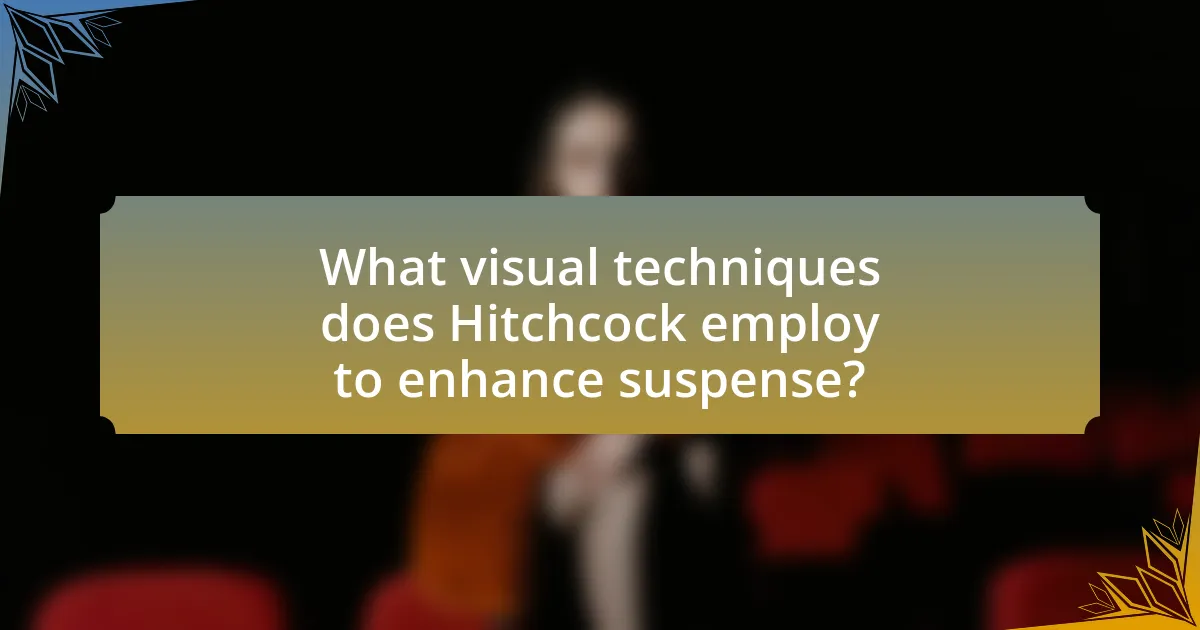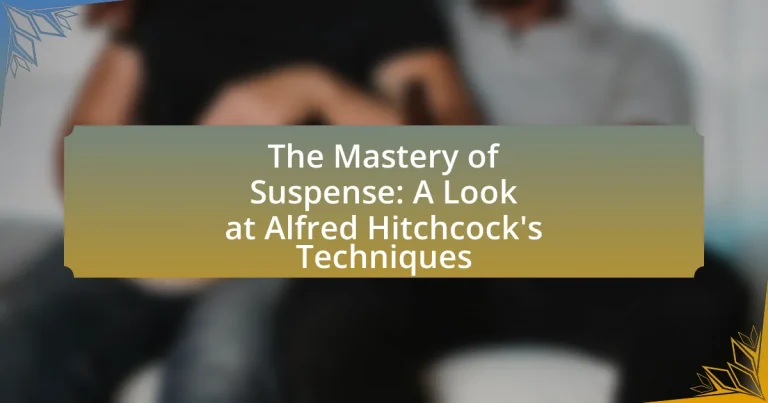The article examines the mastery of suspense in Alfred Hitchcock’s films, highlighting key elements such as dramatic irony, pacing, and psychological tension. It explores how Hitchcock builds tension through narrative techniques, character development, and visual storytelling, including the use of camera angles, lighting, and sound design. The discussion also covers the role of editing in creating suspenseful sequences and the emotional impact of music and silence. Additionally, the article offers insights for modern filmmakers on applying Hitchcock’s techniques while identifying common pitfalls to avoid in suspenseful storytelling.
What are the key elements of suspense in Alfred Hitchcock’s films?
The key elements of suspense in Alfred Hitchcock’s films include the use of dramatic irony, pacing, and psychological tension. Hitchcock masterfully employs dramatic irony by allowing the audience to know critical information that the characters do not, creating a sense of anticipation and dread. For instance, in “Psycho,” viewers are aware of Norman Bates’ true nature long before Marion Crane does, heightening the suspense. Additionally, Hitchcock’s meticulous pacing builds tension through carefully timed reveals and cliffhangers, as seen in “Rear Window,” where the protagonist’s observations lead to escalating stakes. Finally, psychological tension is a hallmark of Hitchcock’s work, often exploring themes of guilt, fear, and obsession, which resonate deeply with audiences, as exemplified in “Vertigo.” These elements collectively establish a gripping atmosphere that keeps viewers on the edge of their seats.
How does Hitchcock build tension throughout his narratives?
Hitchcock builds tension throughout his narratives by employing techniques such as suspenseful pacing, psychological manipulation, and visual storytelling. He often uses the “MacGuffin” to create a focal point of tension, where the audience is aware of critical information that the characters are not, heightening anxiety. For example, in “Psycho,” the audience knows about the impending danger of Norman Bates long before Marion Crane does, creating a sense of dread. Additionally, Hitchcock’s use of close-ups and framing emphasizes characters’ emotions and reactions, further intensifying the viewer’s engagement with the narrative. His mastery of sound design, including the strategic use of silence and jarring sound effects, also amplifies tension, as seen in “The Birds,” where the absence of music creates an unsettling atmosphere. These techniques collectively establish a gripping experience that keeps audiences on the edge of their seats.
What techniques does he use to create anticipation in the audience?
Alfred Hitchcock creates anticipation in the audience through techniques such as suspenseful pacing, strategic use of music, and visual storytelling. He meticulously builds tension by delaying the resolution of conflicts, often employing a slow reveal of critical information to keep viewers on edge. For instance, in “Psycho,” the iconic shower scene is preceded by a gradual buildup of tension through music and camera angles, heightening the audience’s anxiety. Additionally, Hitchcock’s use of dramatic irony, where the audience knows more than the characters, amplifies anticipation, as seen in “Rear Window,” where viewers are aware of the potential danger while the protagonist remains oblivious. These techniques effectively engage the audience, making them eager to see how the story unfolds.
How does pacing contribute to the overall suspense in his films?
Pacing significantly contributes to the overall suspense in Alfred Hitchcock’s films by controlling the rhythm of the narrative and the timing of key events. Hitchcock expertly manipulates pacing to build tension, often employing slow, deliberate sequences that heighten anticipation before sudden, shocking moments. For instance, in “Psycho,” the gradual buildup of tension in the shower scene, followed by a rapid, jarring climax, exemplifies how pacing can create a visceral emotional response. This technique keeps audiences on edge, as they are unsure when the next moment of suspense will occur, effectively maintaining their engagement throughout the film.
Why is character development crucial in Hitchcock’s suspense?
Character development is crucial in Hitchcock’s suspense because it creates emotional investment and heightens tension. By crafting complex characters with relatable motivations and flaws, Hitchcock allows audiences to empathize with their struggles, making the suspense more impactful. For instance, in “Psycho,” the character of Norman Bates is developed through his troubled past and psychological complexity, which not only elicits sympathy but also deepens the horror when his true nature is revealed. This technique of character depth ensures that viewers are not just passive observers but are actively engaged in the unfolding drama, amplifying the suspense throughout the narrative.
How do protagonists and antagonists shape the viewer’s emotional response?
Protagonists and antagonists significantly shape the viewer’s emotional response by creating a dynamic of empathy and conflict. Protagonists often evoke feelings of sympathy and support, as viewers connect with their struggles and aspirations, while antagonists typically generate feelings of fear, anger, or disdain due to their opposition to the protagonist’s goals. For instance, in Alfred Hitchcock’s films, the clear delineation between the hero and villain intensifies suspense, as viewers become emotionally invested in the protagonist’s journey and the obstacles posed by the antagonist. This emotional engagement is supported by psychological theories, such as the identification theory, which suggests that viewers experience heightened emotional responses when they identify with characters, leading to a more immersive viewing experience.
What role do secondary characters play in enhancing suspense?
Secondary characters play a crucial role in enhancing suspense by creating tension and uncertainty within the narrative. Their actions and motivations often serve to complicate the protagonist’s journey, introducing obstacles that heighten the stakes. For instance, in Alfred Hitchcock’s films, secondary characters frequently possess hidden agendas or conflicting loyalties, which can lead to unexpected twists and turns. This unpredictability keeps the audience on edge, as they cannot easily anticipate how these characters will influence the outcome of the story. Additionally, secondary characters can provide critical information or misdirection, further amplifying the suspenseful atmosphere.

What visual techniques does Hitchcock employ to enhance suspense?
Hitchcock employs several visual techniques to enhance suspense, including the use of framing, lighting, and camera angles. For instance, he often utilizes close-ups to capture characters’ emotions, creating an intimate connection with the audience and heightening tension. Additionally, Hitchcock’s strategic use of shadows and low-key lighting contributes to an ominous atmosphere, making viewers feel uneasy. His innovative camera angles, such as the famous “dolly zoom,” effectively manipulate perspective and evoke a sense of disorientation, further amplifying suspense. These techniques are evident in films like “Psycho” and “Rear Window,” where visual storytelling plays a crucial role in building tension and engaging the audience.
How does cinematography contribute to the feeling of unease?
Cinematography contributes to the feeling of unease by employing techniques such as unconventional camera angles, lighting contrasts, and framing that disrupt the viewer’s sense of comfort. For instance, low-angle shots can create a sense of vulnerability, while high-contrast lighting can cast unsettling shadows, enhancing tension. Alfred Hitchcock frequently utilized these methods, as seen in “Psycho,” where the stark lighting and disorienting angles amplify the viewer’s anxiety during critical scenes. This strategic use of visual elements effectively manipulates audience emotions, reinforcing the overall atmosphere of suspense and discomfort.
What specific camera angles and movements does he favor?
Alfred Hitchcock favors low-angle shots and tracking movements to enhance suspense and tension in his films. Low-angle shots create a sense of power and dominance, often making characters appear more threatening or significant. For instance, in “Psycho,” the use of low angles during key scenes amplifies the psychological impact on the audience. Additionally, Hitchcock employs tracking shots to follow characters closely, which builds anticipation and immerses viewers in the unfolding drama. This technique is evident in “Rear Window,” where the camera movement draws the audience into the protagonist’s perspective, heightening the suspense.
How does lighting influence the mood and tension in his films?
Lighting significantly influences the mood and tension in Alfred Hitchcock’s films by creating visual contrasts that evoke emotional responses. Hitchcock expertly uses low-key lighting to generate shadows and ambiguity, which heightens suspense and creates a sense of foreboding. For instance, in “Psycho,” the stark contrasts between light and dark during the infamous shower scene amplify the shock and horror, making the audience feel the tension acutely. Additionally, Hitchcock’s strategic use of lighting to isolate characters, such as in “Rear Window,” enhances feelings of vulnerability and anxiety, as the audience is drawn into the characters’ emotional states. This deliberate manipulation of lighting not only shapes the atmosphere but also guides the viewer’s psychological experience throughout his narratives.
What role does editing play in creating suspenseful sequences?
Editing plays a crucial role in creating suspenseful sequences by controlling the pacing and rhythm of the narrative. Through techniques such as quick cuts, cross-cutting, and the strategic use of silence, editing heightens tension and keeps the audience on edge. For instance, Alfred Hitchcock often employed rapid editing during climactic moments to accelerate the viewer’s heartbeat, as seen in “Psycho” during the infamous shower scene. This method effectively manipulates time perception, making moments feel longer and more intense, thereby amplifying suspense.
How does the rhythm of cuts affect the viewer’s experience?
The rhythm of cuts significantly influences the viewer’s experience by controlling pacing and emotional engagement. In film, a rapid succession of cuts can create tension and urgency, while slower cuts allow for reflection and emotional depth. For instance, Alfred Hitchcock often employed varying rhythms in his editing to manipulate audience reactions; in “Psycho,” the quick cuts during the shower scene heighten suspense and shock, effectively immersing viewers in the protagonist’s fear. Research indicates that editing pace can alter viewers’ physiological responses, such as heart rate and adrenaline levels, demonstrating the direct impact of cut rhythm on emotional engagement.
What techniques does Hitchcock use to manipulate time and space in editing?
Hitchcock employs techniques such as montage, cross-cutting, and temporal ellipsis to manipulate time and space in editing. Montage allows for the juxtaposition of images to create a narrative that compresses time, as seen in the rapid sequence of shots in “Psycho” during the shower scene, which heightens tension. Cross-cutting, used in films like “North by Northwest,” creates parallel narratives that manipulate the viewer’s perception of time and space by shifting between different locations and events simultaneously. Temporal ellipsis, where scenes are omitted to advance the story, is effectively utilized in “Rear Window,” allowing the audience to infer the passage of time without explicit depiction. These editing techniques contribute significantly to Hitchcock’s ability to build suspense and engage viewers.
How does sound design impact the suspense in Hitchcock’s work?
Sound design significantly enhances suspense in Hitchcock’s work by manipulating auditory elements to evoke emotional responses. Hitchcock expertly utilized sound effects, silence, and music to create tension and anticipation, as seen in films like “Psycho,” where the iconic shower scene employs a shrill score that heightens fear. The absence of sound can also amplify suspense, as demonstrated in “Rear Window,” where the stillness accentuates the protagonist’s anxiety. These techniques illustrate how sound design is integral to building suspense, making audiences more engaged and emotionally invested in the narrative.
What types of sound effects are commonly used to heighten tension?
Sound effects that commonly heighten tension include dissonant musical scores, sudden loud noises, and ambient sounds that create unease. Dissonant scores, often characterized by unsettling harmonies, are used to evoke anxiety and anticipation, as seen in Hitchcock’s films like “Psycho.” Sudden loud noises, such as a door slamming or a scream, serve to jolt the audience, creating a visceral reaction. Ambient sounds, like distant thunder or whispering winds, contribute to an atmosphere of dread, enhancing the viewer’s sense of foreboding. These techniques are integral to suspenseful storytelling, effectively manipulating audience emotions and expectations.
How does silence function as a tool for suspense in his films?
Silence functions as a crucial tool for suspense in Alfred Hitchcock’s films by creating an atmosphere of tension and anticipation. In scenes devoid of dialogue or sound, the audience is left in a heightened state of awareness, acutely attuned to visual cues and subtle movements. This technique amplifies the emotional stakes, as viewers are compelled to fill the silence with their own fears and expectations. For instance, in “Psycho,” the absence of sound during the infamous shower scene intensifies the horror, making the eventual violence more shocking. Hitchcock’s strategic use of silence effectively manipulates audience emotions, reinforcing the suspenseful narrative and keeping viewers on edge.
What role does music play in building emotional responses during suspenseful moments?
Music plays a crucial role in building emotional responses during suspenseful moments by enhancing tension and guiding audience reactions. In Alfred Hitchcock’s films, for instance, the use of dissonant chords and escalating rhythms creates an atmosphere of unease, effectively heightening the viewer’s anxiety. Research indicates that music can influence emotional perception; a study published in the journal “Psychological Science” found that suspenseful music significantly increased feelings of tension and anticipation in viewers. This demonstrates that music not only complements visual elements but also actively shapes the emotional landscape of suspenseful scenes.
What lessons can filmmakers learn from Hitchcock’s mastery of suspense?
Filmmakers can learn the importance of audience engagement and tension-building from Hitchcock’s mastery of suspense. Hitchcock effectively utilized techniques such as the “bomb theory,” where the audience is made aware of a threat before the characters, creating anticipation and anxiety. For example, in “Rear Window,” the audience knows about the potential danger before the protagonist does, heightening the suspense. Additionally, Hitchcock’s use of pacing, visual storytelling, and sound design, such as in “Psycho” with its iconic shower scene, demonstrates how to manipulate viewer emotions and maintain tension throughout a film. These techniques underscore the significance of strategic storytelling in creating suspenseful narratives.
How can modern directors apply Hitchcock’s techniques to their own work?
Modern directors can apply Hitchcock’s techniques by utilizing suspenseful storytelling, innovative camera angles, and psychological depth in character development. Hitchcock masterfully built tension through pacing and the strategic use of silence, which modern filmmakers can replicate by carefully controlling the rhythm of their narratives and employing sound design to enhance emotional impact. Additionally, Hitchcock’s use of the “MacGuffin” to drive the plot can inspire contemporary directors to create compelling motivations that engage audiences. His emphasis on visual storytelling, such as framing and composition, can also guide modern filmmakers in crafting visually striking scenes that convey meaning without dialogue. These techniques have been validated by Hitchcock’s enduring influence on the thriller genre, evidenced by the continued success of films that adopt similar suspenseful elements.
What are some common pitfalls to avoid when trying to create suspense?
Common pitfalls to avoid when trying to create suspense include revealing too much information too early, which diminishes tension, and failing to establish a clear stakes scenario, which can leave the audience disengaged. Additionally, relying on clichés or predictable plot twists can undermine the effectiveness of suspense, as audiences may anticipate outcomes rather than feel genuine uncertainty. Inconsistent pacing can also disrupt suspense; if the narrative moves too quickly, it can rush the buildup, while too slow a pace can lead to boredom. These pitfalls are critical to recognize, as effective suspense relies on maintaining intrigue and emotional investment throughout the narrative.


